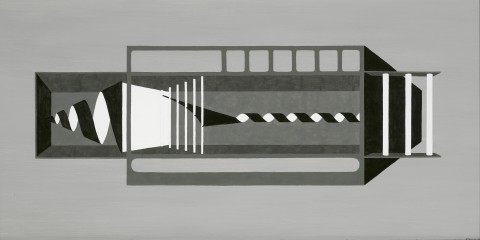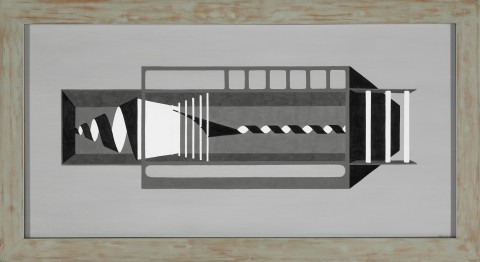FLIGHT OF A MAGPIE II, 1995
HOWARD TAYLOR
oil and synthetic polymer paint on marine plywood
61.0 x 122.0 cm
signed and dated lower right: H TAYLOR ‘95
signed, dated and inscribed with title verso: FLIGHT of a MAGPIE II / H TAYLOR 1995
Taylor Family, Western Australia, gift from the artist
Dufour, G., Howard Taylor: A Painter’s Journal, Art Gallery of Western Australia, Perth, 2025, p. 10 (illus.)
Flight of a magpie, 1956, egg tempera on composition board, 61.2 x 122.0 cm, illus. in Dufour G., Howard Taylor Phenomena, Art Gallery of Western Australia, Perth, 2003, p. 43 (work destroyed by the artist)
Study for ‘Flight of a magpie’, 1956, pencil on paper, 28.0 x 38.4 cm, Art Gallery of Western Australia, Perth
240444 Howard Taylor.jpg

One of Australia’s most admired contemporary artists, Howard Taylor’s interests in flight were first revealed as an avid model-maker while attending Perth Modern School in 1936. A pilot in WWII with both the RAF and RAAF, the experience of flight informed his art which was simultaneously rigorous, ingenious and underscored by a mastery of materials. The recipient of the inaugural Australia Council Emeritus Award, two Honorary Doctorates and recognised in Western Australia as a State Cultural Treasure and Citizen of the Year, Taylor’s art is in the collections of the National Gallery of Australia and all the state Galleries.
Taylor wrote to me often, and about flight twice, first in 1985 and again in 1998. He was keen to outline the chronology of his 1956 Flight series and how it coincided with ‘three dimensional interests occurring about the same time and an involvement with actual structures and sculptures… I painted Flight of a magpie with the figure / ground movement supported by the internal action of movement and space… interested in, fore and aft movement, aircraft structure and behaviour in the sky… Flight of a magpie precedes all the other jobs.’ Notes on this subject span years, and the artist’s journal served as a personal resource to support a master of painterly technique, something which sustained an ambition to know reality and transform visual discoveries into art.
Taylor constantly refined his interest in flight as a subject while seeking to understand through painting how the interaction of support, colour, texture and technique could serve artistic vision. Flight of a magpie II, 1995 is unique in many regards – a composition conceived in 1956, painted first in egg tempera, exhibited in 1957 and 1985, and gifted to his daughter. In 1995, the artist destroyed the first version and replaced it with this second version in oil and acrylic. He reused the original artist’s frame which, in depth and treatment, clearly indicates that Flight of a magpie was conceived to be an object on the wall – the earliest occurrence of this hallmark in the artist’s oeuvre. Taylor set himself the complex problem of bringing viewers beyond what he described as simply recognition. He was familiar with a technique known as grisaille from his study of Flemish painters as a student. His notes for this painting, like so many, are extensive and reveal the challenges of painting in shades of grey. Notations indicate the use of cool and warm whites and blacks in varying mixtures – opaque, translucent and pearlescent. And the greys are colourful, combinations enhanced with yellow ochre and red. Any modelling, a typical feature of grisaille, was subordinated so contour action could dominate, something highlighted in his notes.
Flight of a magpie II is situated at the very crux of a lifelong exploration of imagined and actual three-dimensional forms; something that was very much front of mind for the artist in 1995. Taylor was again building maquettes to use as subjects for paintings (such as Colonnade study, 1995) and producing monochromatic white wall reliefs. The title of one, No horizon, 1994 (National Gallery of Australia), is a reference to the spatial disorientation experienced by pilots – an example of the artist’s continuing interest in this optical phenomenon.
Taylor often revisited subjects and motifs so when the opportunity arose to create Flight of a magpie II, he had forty years of experience upon which to draw, an artist at the pinnacle of his powers. What makes this painting utterly unique as the aesthetic summation of the Flight series is a composition from early in his career rethought and rendered with hands, heart, and mind steeped in a lifetime of artistic excellence.
Taylor endeavoured to create analogies for what exists, what can be seen and what can be understood, and he never hesitated in reengaging with ideas first entertained decades earlier. Flight of a magpie II is a testament to the artist’s belief that the more one looks the more enlightening and replenishing visual experience in the Australian bush becomes. It also reminds me of his inimitable dry wit; as he reflected around this time, ‘What does it take to be a good artist? Two ideas and a lot of hard work. And why most artists fail is because they spend their time looking for a third idea and do not put in the arduous work required to fully realise the first two.’
GARY DUFOUR


